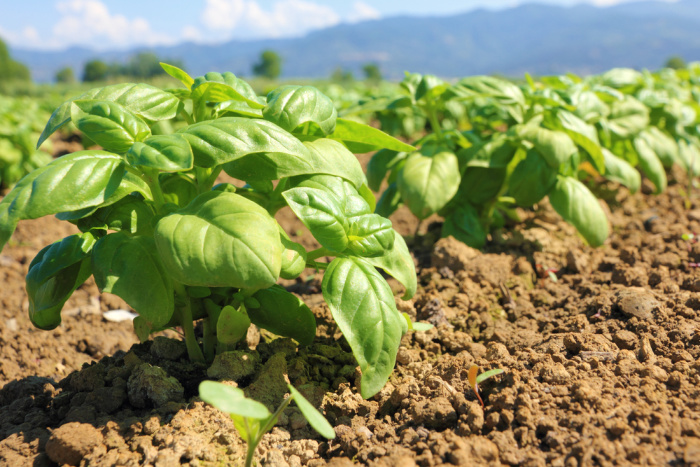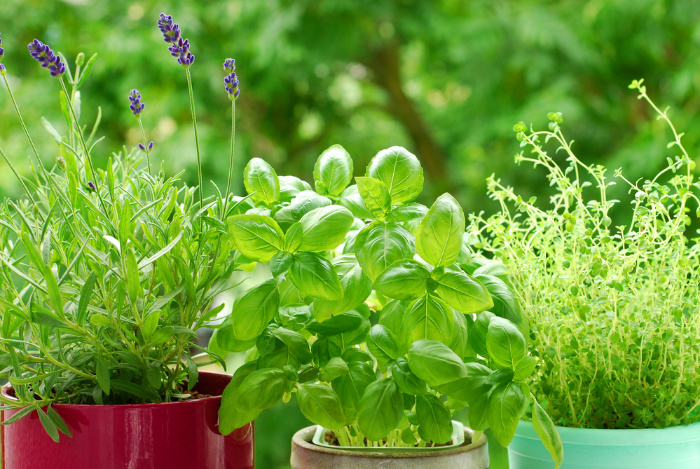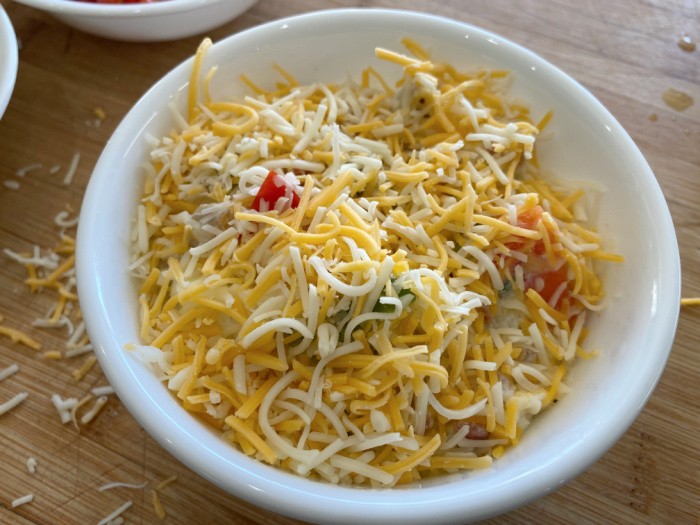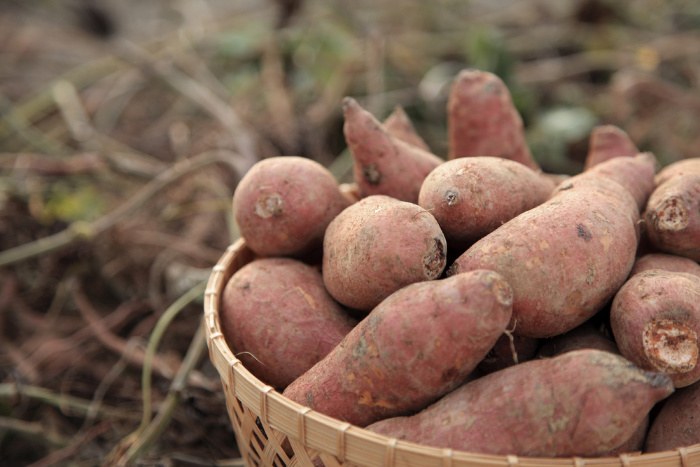Basil: Everything You Need To Know
If you have an assortment of spices and herbs tucked away in your kitchen, there’s no way basil wouldn’t be found among the lot. This sweet herb is about as popular as they come. It’s probably because it has a pleasant sweet taste to it. Let’s dig into basil: everything you need to know.
You can use basil on spaghetti, homemade pizza, and a number of other Italian dishes or meats that are prepared in your kitchen, or even to spice up a hot cup of tea.
There are several health benefits that come along with this friendly herb that you may not be aware of. Here’s more on basil and everything you need to know.
Basil: Everything You Need to Know

Basil, or Ocimum Basilicum, comes from the mint family and happens to be one, if not, the most popular of all the herbs on the planet. It’s a perennial that does well in hotter temperatures.
It’s grown and cultivated for its aromatic leaves and can be used fresh, dried, or in an oil extract.
Fun Facts
Basil is usually associated with Italian cuisine, but it actually came from India, or possibly even as far as China, around ancient times by merchants traveling along the spice route to the Mediterranean world.
The herb has been found several times in Egyptian mummy coffins because it helped in their process to embalm the dead.
People bitten by snakes were often given basil as an antidote, and it was believed to give a person strength. It may have even been used as part of a love spell to ensure faithfulness.
The Hindus believed that holy basil was associated with protection, purification, and eternal life, especially during burial.
Varieties
There are at least 150 species of basil, but most of them are cultivars of sweet basil (O. basilicum). Their colors range from a dark purple to a pale green and their leaves come in all different shapes and sizes. Let’s take a look at the 5 most common ones.
Sweet (Genovese)
The most common of all the basil varieties, the Genovese basil, or sweet basil, is what you’ll most likely find when you head to the grocery store. It has more of a pepper flavor, along with a strong aroma. It goes great in pasta dishes, pesto, and basil sugar.
Thai
Thai basil has a spicy licorice flavor that tastes good in curries, Thai Stir-frys, and Vietnamese dishes. The flowers and stems are purple and the plant has small and pointy leaves.
Opal
Opal, or purple basil, is extremely dark purple in color, just like an eggplant. This goes for the flowers, the stem, and its leaves. It has a more subtle flavor than the genovese basil.
Lemon
Lemon basil has a noticeable citrusy flavor just like its name suggests, along with its clove and anise notes. This variety is known for its larger leaves.
Cinnamon
Cinnamon basil has a spicy flavor and goes great in a garnish or fruit salad. It has small leaves and dark purple flowers and stems.
Nutrition Facts
Basil is an excellent source of a number of vitamins and minerals. Several of these include Vitamin A, C, K, manganese, calcium, copper, iron, folate, magnesium, and omega-3 fatty acids. It also happens to be calorie-free.
Health Benefits
Supports a Healthy Heart
Sweet basil has been found to briefly lower blood pressure because of the eugenol content that’s found in the extract. Dried tulsi leaf extract has been proven to lower cholesterol and triglyceride levels, which suggests that it may also help reduce the risk of certain cardiovascular diseases.
Lowers High Blood Sugar
There are certain practitioners out there who suggest that basil can help you manage blood sugar levels. There have been animal studies performed on rats where they discovered that sweet basil leaves helped to reduce high blood sugars in the animals.
With this evidence, basil extracts may be quite helpful for patients that struggle with diabetes.
Helps Prevent Cancer
There has been research done on animals that conclude basil may also help prevent or lower the risk of certain types of cancer, including lung, skin, oral and liver cancer.
This is due to the phytochemical and antioxidants that are in basil.
Boosts Mental Health
Who couldn’t use a mental pick me up now and then? The tulsi plant contains certain properties that may increase our thinking and reasoning capability, as well as reducing anxiety, stress, or even depression.
It can even give you a boost of energy. There’s the possibility that it may also help with age-related memory loss.
Reduces Oxidative Stress
Antioxidants work to eliminate any free radicals that may begin to build up, causing oxidative stress in our bodies. If left untreated, this can lead to cell damage or disease.
A few of these health issues include diabetes, heart disease, cancer, arthritis, and several others.
Our bodies already make antioxidants, but they also need outside help from those that are absorbed from our diets. Beta carotene and anthocyanins are the two main antioxidants found in basil.
Helps to Reduce Inflammation and Swelling
Oxidative stress that we just mentioned can sometimes cause swelling and inflammation. Basil oil may help to reduce these because of its anti-inflammatory properties.
Protects against Skin Aging
Are you looking for another way to have younger and healthier skin? Basil may be the answer. Consuming basil will not have any effect on your skin, but applying basil extracts in a topical skin cream not only moisturizes drying skin, but also helps reduce wrinkling and roughness.
Fights Infections
Basil oil may also be used to treat or prevent several different types of strains of infections, with Escherichia coli (E. coli) being one in particular.
How to Store Fresh Basil
In order to keep basil fresh, you’ll need to trim the stems and place them in a cup of water, just as you would flowers. Go ahead and place a plastic bag over it and leave it on the counter.
Many herbs do well by being placed in the refrigerator, but basil does better being stored at room temperature. But if you just harvested a bunch from your garden, I place the leaves in one of these in my refrigerator: Vegetable Container
You can even freeze basil, if you wish to. Make sure that you remove the moisture from the basil and then place it on a baking sheet in a single layer.
After that, go ahead and put it in a freezer bag and get as much of the air out of the bag as you can before placing it in the freezer. It should last for around 6 months this way. How’s that for basil: everything you need to know?
Final Word
By now we hope you’ve realized that basil is more than just your typical herb that sweetens up a recipe, but also helps us in a number of different ways.
Are you looking for recipes and other ways that you can incorporate basil for various uses on a more consistent basis?
If so, check out these recipes that you can get started on from the Food Network. Are you a big tea drinker?
Try this basil tea recipe that comes straight from India. What do you think about basil: everything you need to know? May God bless this world, Linda
How To Grow Basil In The Garden
Copyright Images: Basil Deposit photos_3354759_s-2019, Basil Growing Deposit photos_6867621_s-2019























Basil is one of my favorites to “graze” when I’m in the garden! I love to plant it in between my tomato plants.
Hi Rhonda, isn’t it wonderful???? I love it! Linda
Ah – Linda – my basil is growing on my deck as we speak! I just watched a youtube video on growing basil and how to maintain the plant, cultivate it and make the plants bushier! It is by Epic Gardening called How to prune basil so it grows forever! I found it interesting and plan to use his pruning technique on my own plant.
Hi Leanne!!! Oh my gosh, I love hearing this!! Woohoo!! Love this! Linda
Linda, another fact about basil is that it helps repel tomato hornworms on your tomato plants. Plant a few around your plants along with marigolds( the smelly kind!). I have done it for many years after I lost all my tomato plants to the huge caterpiller. Besides, it is there when you need it to make tomato sauce, etc. It seems to give a better flavor to the tomato plants, as well. It isn’t a perenial here in my state unless I bring a plant inside in the winter. I have some plants in my tomato bed and some in pots on my deck . Either way , it smells wonderful when you are around them. Thank you for the good info.
Hi Cheryl, I love the smell of basil, I will try planting some next to my tomatoes! A great tip for the HUGE green hornworms!!! Yay! Linda
I just found out something interesting about making pesto. If you blanch the basil for 5-10 sec, and then place in ice water, it stops the enzymes from causing the leaves to darken and helps with the looks and flavor. It only needs to be a few seconds so be very careful on the time! Hope this helps!
Hi Cheryl, oh, I love this tip on blanching the basil! Thank you, Linda